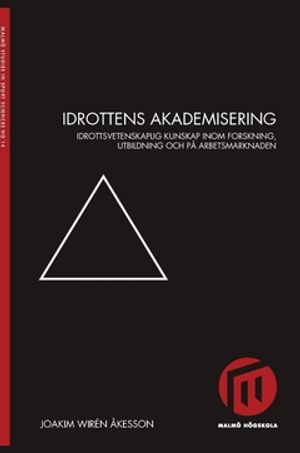Vi har bytt namn till Adlibris Campus! Campusbokhandeln ❤️ Adlibris - Läs mer här

Idrottens akademisering : idrottsvetenskaplig kunskap inom forskning, utbildning och på arbetsmarknaden
- Häftad, Svenska, 2017
- Författare: Joakim Wirén Åkesson
- Betyg:
Från
216
kr
Finns i lager i .
Beskrivning
Malmö studies in sport sciences nr 14.
Abstract Purpose: The purpose of this thesis is to analyse the academisation of sport in Sweden. This is done by mapping and analysing the scientific knowledge produced in sport research which is then mediated through academic sport education and demanded on the sport labour market. The relationship between these three arenas is also analysed. Various problems, subjects and perspectives which are focused in the arenas above are analysed, as well as the various conditions under which scientific knowledge is produced, mediated and demanded. Finally, the knowledge which is produced, mediated and demanded is analysed in relation to each other. Theory: Academisation can be considered as the process by which scientific knowledge expands and grows in importance for the area of knowledge as a whole. The academic status of an area of knowledge is dependent on the role of scientific knowledge within research, education and in the field of practice. In this thesis, the focus is on the academisation of the specific area of knowledge of sport. The production of scientific knowledge in sport research, mediation of scientific knowledge in higher sport education, application of scientific knowledge in the field of practice and the relationship between the three knowledge arenas is analysed. The study also includes an institutional perspective. Methodology: The thesis consists of three empirical part-studies: sport research, higher sport education and the labour market of sport. Each part-study has its own specific empirical data and specific approach for the collection, processing and analysis of data. Various documents comprise the main source of empirical data in this thesis, and the main methodological approach is content analysis and analysis of existing data. Results: The academisation process of sport in Sweden has come a long way. Today there exists extensive sport research in a wide range of disciplines with a strong core within a few of them. Academic sport education, with two distinct branches/orientations, has been established. There are also employers in the sport labour market seeking employees with academic backgrounds, including a wide variety of organisational types and activities. The way sport is handled and where interest is directed within, however, varies between the arenas of research, education and the labour market; there are diverse traditions and interests within each one. Also, in some areas, the arenas are more in tune with each other than in other areas. As a consequence of research, education and the labour market having been established and institutionalised during different eras and under varying ideological circumstances, they possess different logics as part of their ideological structures. They reproduce specific, historically-shaped patterns of thinking and behaviour. This also explains why research, education and the labour market looks so disparate in terms of what scientific knowledge is being produced, mediated and demanded. In areas where institutionalisation has occurred for a long time, there is a clear reproduction of patterns of thought and action; actors in such areas can be said to be more “path dependent” than others. As a result of sport education being institutionalised to such a low degree, it is also more customisable and flexible compared to the thoroughly-institutionalised sport research; however, it lacks the stability and continuity of sport research. Therefore, education also has, to a larger extent, an ability to adapt to the prevailing ideas and logic of the times, such as market logic – for better or for worse. The academisation of sport can thus be seen as an uneven process or a process “out of step”. Scientific knowledge has different characteristics within sport research, higher sport education and the sport labour market due to disparate institutional conditions and different histories of the different academic arenas. They are, in other words, “children of different times”.
Produktinformation
Kategori:
Samhälle & politik
Bandtyp:
Häftad
Språk:
Svenska
Förlag:
Holmbergs i Malmö
Upplaga:
0
Utgiven:
2017-04-12
ISBN:
9789171045430
Sidantal:
238